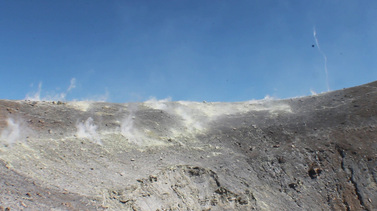 Small "gas devil" at Vulcano, photo by me. Small "gas devil" at Vulcano, photo by me. This (brief!) post spawned from a series of recent video and photo discoveries from Twitter and YouTube. The first time I observed a dust devil was at Vulcano only a few months ago. Although, I suppose it should really be called a gas devil as it was the condensed volcanic gases which made the phenomenon visible! The photo on the right of Vulcano illustrates this and the video at the very bottom shows the formation and development of the "gas devil". Interestingly enough a "gas devil" was seen emanting from almost exactly the same location several times over the course of the few days we spent at the summit. This leads us to the question, what forms them? I am by no means an atmospheric expert but here goes... The key component is the heating of the ground which creates a large enough temperature difference between the air near to the ground and the air above it (i.e. creating a density difference). This then starts a process of convection (not an unfamiliar topic in volcanology, a similar process likely occurs within volcanic conduits). Following this all that is needed are appropriate wind conditions to push the dust devil into a vertical position and viola! This process probably occurs a lot more often than we observe, as it is with the entertainment of particles that dust devils become visible! A couple of good explanations (which helped a lot!) are included here and here (along with a good graphic in the latter one).  Dust devil at Santiaguito, Photo by: Tom Pfeiffer Dust devil at Santiaguito, Photo by: Tom Pfeiffer So taking this new found knowledge and applying it to a couple of volcanic situations... In the case of Vulcano the heat comes from both the incoming solar radiation and potentially the heat of the fumarole(s) with a nice side wind over the edge of the crater. In the case of Sinabung (video below) it is entirely possible that the ground (and air) is super-heated by the pyroclastic density currents which have just rolled by, leading to some fantastic examples! Many thanks are due to Oliver Lamb and Rudiger Escobar Wolf for links to photos of Colima (click on on Oliver Lambs name) and Sanitaguito (photo to the left). Also to Luca D'Auria for the initial post in a Facebook group. Dust devils have also been observed at volcanoes such as Mt. St. Helens and some fantastic examples at Sinabung, which are so good I had to included the YouTube video below. Of course dust devils such as this don't just occur at volcanoes and have also been observed on Mars!
Deterrent
24/7/2014 10:04:36 am
Fantastic stuff to watch. Too bad there wasn't video during the time of <a href="http://www.youtube.com/watch?v=l1rZ3-pfTvA">Krakatoa and all that</a>. That would have been amazing to see. Comments are closed.
|
Archives
July 2023
|

 RSS Feed
RSS Feed